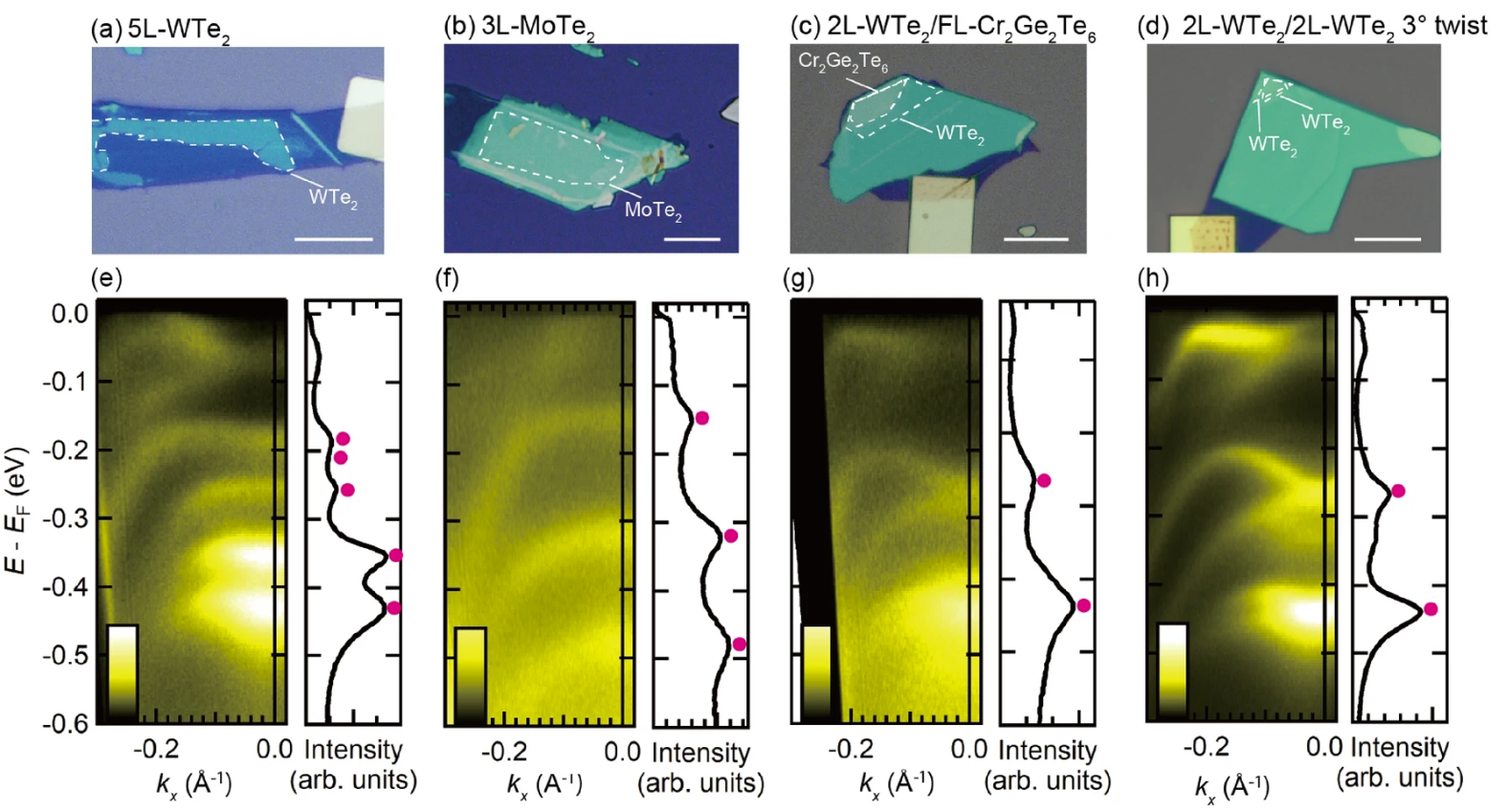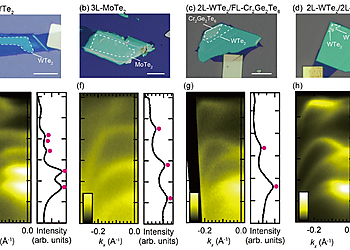Dry pick-and-flip assembly of van der Waals heterostructures for microfocus angle-resolved photoemission spectroscopy
Result of the Month
In this letter, we present a dry pick-and-flip assembly technique for the ARPES of van der Waals heterostructures by employing the differences in the glass transition temperatures of a polymer composed of Elvacite2552C acrylic resin and 1-ethyl-3-methylimidazolium ionic liquid (IL). First, we characterized the thermal properties of Elvacite2552C–IL compounds. Figure 1a shows their differential scanning calorimetry (DSC) for different IL contents (red) 0, (blue) 23.5, and (green) 41.5 wt%. For all the IL contents, the DSC curves exhibit step-like transitions, indicating an increase in the heat capacities [black dashed lines]. This indicates that Elvacite2552C-IL exhibits a transition from a brittle state to a plastic state, that is, glass transition. The temperature at the middle of the sloped region is taken as the Tg [black arrows in Fig. 1a]. Tg decreases to 100, 70, and 37 ℃ when increasing the IL content to 0, 23.5, and 41.5 wt% (Fig. 1b). Next, we evaluated the mechanical properties of the Elvacite2552C-IL compounds. Here, we investigated the changes in the shape of the Elvacite2552C-IL compounds on a glass slide after touching and detaching them onto the silicon substrate by varying the sample stage temperature Tstage. When Tstage is low, the shape of the Elvacite2552C-IL compounds is unaffected (Supplementary Fig. S1b-(i)). When Tstage is increased, they deform after detaching from the silicon substrate (Supplementary Fig. S1b-(ii)). We define Tstage at which Elvacite2552C-IL compounds undergo deformation as Tdeform. With further increase in Tstage, the Elvacite2552C-IL compounds strongly adhere to the silicon substrates. The polymer residues remained on the silicon substrate (Supplementary Fig. S1b-(iii)). We define Tstage at which Elvacite2552C-IL compounds start adhesion as Tadhere. As shown in Fig. 1c, Tdeform and Tadhere systematically decrease from Tdeform=120∘C to 45∘C (squares in Fig. 1c) and Tadhere=145–60∘C (triangles in Fig. 1c) when increasing the IL content from 0 to 39.4 wt%. These results indicate that the IL functions as a volatile plasticizer for Elvacite2552C, and Tg of Elvacite2552C can be systematically controlled using the IL content.
Figure description: (Upper panels) Optical microscopic images of (a) 5-layer WTe2, (b) 3-layer MoTe2, (c) 2-layer WTe2/few-layer Cr2Ge2Te6, and (d) twisted double 2-layer WTe2 with a rotation angle of 3∘. These flakes are encapsulated between monolayer graphene and graphite. The white scale bar corresponds to 10 μm. (Lower panels) The ARPES images of (e) 5-layer WTe2, (f) 3-layer MoTe2, (g) 2-layer WTe2/few-layer Cr2Ge2Te6, and (h) twisted double 2-layer WTe2 recorded along the kx direction. For the twisted double 2-layer WTe2, the kx axis is set to the direction tilted ± 1.5 degrees from the kx axes of the top and bottom 2-layer WTe2. Energy distribution curves at kx=0 obtained with an integral width of 0.04/Å. The red markers indicate the positions of the intensity peaks derived from the topmost WTe2 or MoTe2 flakes.
--
Laser-based micro-focused angle-resolved photoemission spectroscopy (μ-ARPES)
The laser-based µ-ARPES measurement was performed by using a combination of the hemispherical analyzer (DA30-L, Scienta Omicron) and a 6.42 eV laser, installed at the Department of Applied Physics, The University of Tokyo.
--
AUTHORS
Satoru Masubuchi, Masato Sakano, Yuma Tanaka, Yusai Wakafuji, Takato Yamamoto, Shota Okazaki, Kenji Watanabe, Takashi Taniguchi, Jincai Li, Hirotaka Ejima, Takao Sasagawa, Kyoko Ishizaka & Tomoki Machida
--
INSTITUTES
Institute of Industrial Science, The University of Tokyo, 4-6-1 Komaba, Meguro-ku, Tokyo, 153-8505, Japan
- Satoru Masubuchi, Yusai Wakafuji, Takashi Taniguchi & Tomoki Machida
Quantum-Phase Electronics Center and Department of Applied Physics, The University of Tokyo, Bunkyo-ku, Tokyo, 113-8656, Japan
- Masato Sakano, Yuma Tanaka, Takato Yamamoto & Kyoko Ishizaka
Materials and Structures Laboratory, Tokyo Institute of Technology, Yokohama, Kanagawa, 226-8503, Japan
- Shota Okazaki & Takao Sasagawa
Research Center for Functional Materials, National Institute for Materials Science, 1-1 Namiki, Tsukuba, 305-0044, Japan
- Kenji Watanabe
International Center for Materials Nanoarchitectonics, National Institute for Materials Science, 1-1 Namiki, Tsukuba, 305-0044, Japan
- Takashi Taniguchi
Department of Materials Engineering, Graduate School of Engineering, The University of Tokyo, Bunkyo-ku, Tokyo, 113-8656, Japan
- Jincai Li & Hirotaka Ejima
RIKEN Center for Emergent Matter Science (CEMS), Wako, Saitama, 351-0198, Japan
- Kyoko Ishizaka
--
CORRESPONDING AUTHORS
Satoru Masubuchi or Tomoki Machida

